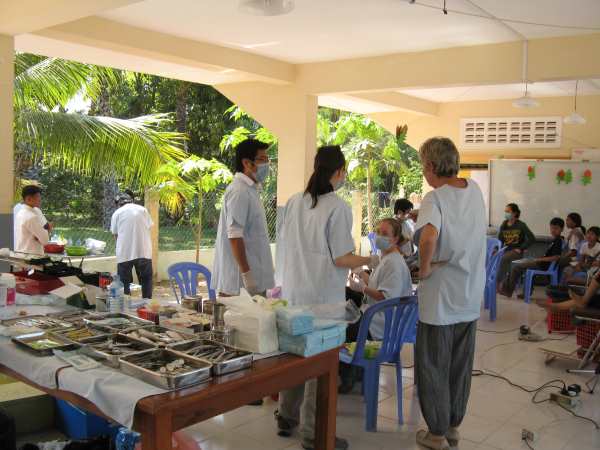
Mobile Dental and Medical Clinic at an orphanage in Phnom Penh.
I am a family physician or what we call in New Zealand, a General Practitioner. I have also travelled frequently in South-East Asia where I have done volunteer work in Cambodia. I therefore think that I am well placed to give recommendations of what to bring in your travel medical kit.
First of all the flight. On long haul flights it is a good idea to wear pressure stockings if you are over 40 or taking the contraceptive pill. The stockings will prevent unpleasant lower leg swelling and the more dangerous Deep Vein Thrombosis (DVT). I experienced mild lower leg oedema for the first time a few years ago after a long flight to Cambodia via Brunei. I didn’t appreciate having “Cankles” (calves that go down to your ankles!) and it took about 3 days for the swelling to go away. So next trip I invested in some flight stockings. Regardless of whether you have stocking or not it’s always a good idea to get up and go for a walk several times during the flight. The contraction of your calves pushes fluid back to the heart and prevents venous blood from stagnating in your lower extremities and extra-cellular fluid collecting in the tissue.
Because of the DVT issue, I don’t encourage people to take long-acting sleeping tablets on flights. If you sleep for hours in a cramped sitting position, that’s just the right conditions for a blood clot to occur. I like to sleep on the plane so sometimes I do take a shot acting sleeping tablet like Triazolam or Zopiclone, but I always ask my travelling companion or a crew member to wake me after 2-3 hours maximum. I also never mix sleeping tablets with alcohol.
My medical kit always contains the following:
– Loperamide (anti-diarrhoea.Fantastic stuff for settling the runs!)
– Buccastem (an anti-nausea drug that is absorbed from under the tongue. I prefer it over pills that you have to swallow because if you are already vomiting then you are not going to keep them down!)
– Electrolyte powder in case you do get a bout of Gastroenteritis. helps replenish the salts that you have lost.
– Antihistamine tablets in case of allergy. I react to insect bites and you never know what you might react to.
– Steroid cream. I like Locoid Lipocream. I apply it to insect bites and I find that they don’t react so badly. I do think it helps sunburn too, but prevention is better of course.
– Water-resistant sticking plasters.
– Cream for vaginal yeast infections, in case!
I would recommend you bring an antibiotic for Urinary Tract Infections if you are prone to them.
I would consider bringing an narrow spectrum antibiotic like Flucloxacillin (not if you are allergic to Penicillin as they are related) for possible skin infections.
I personally don’t bring broad spectrum antibiotics because I don’t like them. They promote bacterial resistance and you are more likely to get a yeast infection. You are unlikely to get an Upper Respiratory Tract Infection in S-E Asia and, if you do, it is mostly likely to be a viral infection which doesn’t require antibiotics. So unless you have Chronic Obstructive Airways Disease I wouldn’t bring antibiotics for a possible viral cold.
I do like to have some Otrivine nasal spray to help with the blocked nose that comes with a cold because I hate mouth breathing. I was able to purchase this easily from a pharmacy in Phnom Pehn when I forgot to bring it from home.
Finally, vaccinations and Malaria prophylaxis. At a minimum you should be vaccinated against Hepatitis A and Typhoid.They should be given at least 1 month before you leave if possible. I have chosen not to have a rabies vaccination as I don’t spend a lot of time in rural areas and I don’t pat dogs or monkeys! Check with your doctor or travel clinic to see if you need Malarial prophylaxis. It depends on your itinerary. Again, prevention is better than cure. Wear light coloured long clothing at dawn and dusk, avoid perfume and apply insect repellent to exposed skin.
Excellent tips for my medical travel kit from someone who knows what they are talking about! Thanks